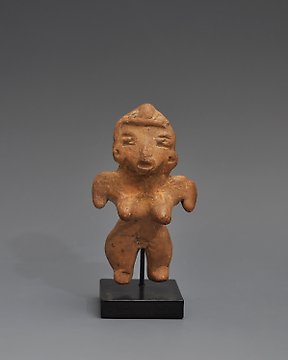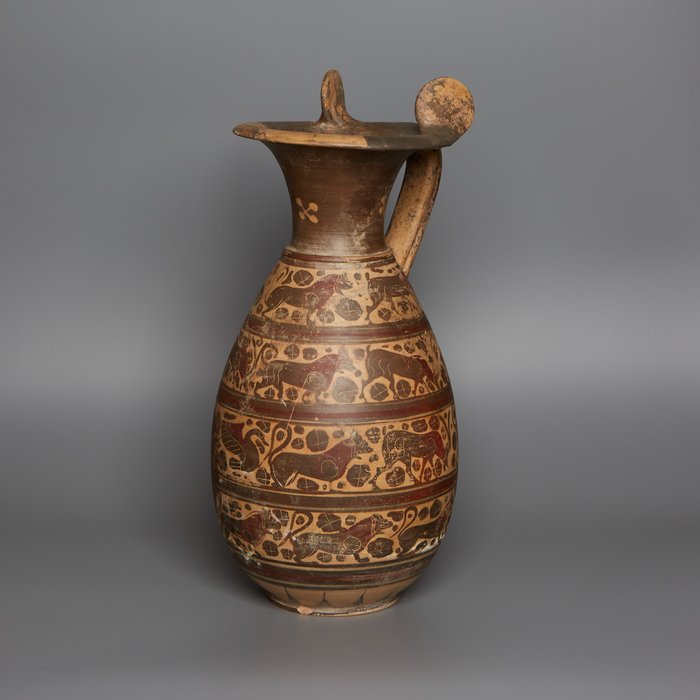
Βερακρούζ, Μεξικό Κεραμικό Γυναικεία φιγούρα με τεστ TL και γερμανική άδεια εξαγωγής. - 7.8 cm
Αρ. 83018883

Αρ. 83018883

Olpe.
- Thermoluminiscense Test! -
- Very Nice Expample -
Etruscan-Corinthian, ca. 600 BC.
Ceramic.
41.5 cm H.
Condition: Good condition. Intact, except for a restoration on the left area of the upper lip. On the right side of the body there is an iron stain caused by contact with an object made of this material while it was buried.
Provenance:
- Private collection, Heinz Hässle (1928 - 2012) from southern Germany, 1970 - 1980. By inheritance to his wife Hilgegard Hässle (1928 - 2022).
- Inherited from his parents Michel Hässle (born June 12, 1955), Berlin.
- Galerie Ghezelbash, Paris.
Description:
Etruscan-Corinthian olpe with an ovoid body, discoidal base and a high, flared neck, which opens notably to form a wide mouth curved outwards, crowned by two vertical flat rosettes located on both sides of the handle. This is vertical, in the form of a ribbon, and is decorated with two longitudinal grooves. The piece is ornamented in the style typical of Corinthian vessels: friezes of animals and mythical beings painted with red and black glazes on the light background of the clay, in contrast to suggest volume. The interior details, which define the anatomy of the animals, are sgraffitoed, standing out in the light tone of the clay.
The decorative surface is organized in four parallel bands that run the entire diameter of the krater, with no other interruption than the handle on the upper band, separated by red, black and sgraffito lines. The neck is covered with black varnish, and is decorated with three fleurons in a cross in reserve, which mark the front and sides of the piece. The upper rosettes show similar motifs in reserve, with eight arms instead of the four of the fleurons of the neck. The lower part of the vessel is adorned with a wreath of triangular leaves, in black on the natural tone of the clay. The figurative friezes are composed of animals in profile, all facing to the right except for the waterfowl next to the handle and the mermaid in the lower register. The number of animals is adapted to the space available: four appear in the upper, shorter band, six in the one below it, and seven in each of the larger, lower bands. On the bottom of the friezes are irregular stipples and spots, with sgraffito interior, which in Corinthian ceramics represent vegetal motifs but which here appear already notably geometrized.
The representations of lions predominate, thirteen in total; all of them appear advancing, with their four paws on the ground, their heads in profile and their jaws open in a threatening attitude. As with the rest of the quadrupeds represented, the upper joint of the lions' front paws is highlighted by a sgraffito circle. Although the representation of the beast is therefore predominant, the figure of the tame ibex is also repeated; there appear to be four in total, and again all represented in the same way, with their heads bent down, grazing, the small beard differentiated and the long horns forming a stylized V on their heads. Two aquatic birds, different from each other, are also represented. One of them, the one facing away from the rest, appears with its wings glued to its body, while the other opens them behind its back, standing upright. The rest of the animals appear only once: a wild boar with bristly mane and large tusks, a ram that, although deteriorated, still shows its characteristic spiral fluted horns, and a donkey that is perhaps the most interesting figure in its composition, given that it tilts its head and turns it, showing it facing the viewer. In these friezes are incorporated, as we have already mentioned, two figures of mythical beings: a sphinx standing on her four legs, with curled wings behind her back and a flat headdress on her head; and a mermaid in profile to the left side, with a human head and a bird's body, with large wings in triangular profile.
The upper band is the only one that has a beginning and an end, as it is interrupted by the handle. It shows two opposing animals flanking the handle - ibex and bird - and between them two lions. In the following frieze, already a continuous scene, three lions appear to parade alternating with two ibexes and a wild boar. The third band, the central and longest, houses the largest variety of animals: sphinx, lion, donkey, ram, waterfowl, lion and ibex. Finally, the lower band shows a row of six lions interrupted by the appearance of the mermaid, located in the opposite direction to the felines. It should be noted that the composition of the different animal friezes does not respond to a symmetrical criterion, and avoids centering the representation on the front of the olpe. On the contrary, the elements that stand out, such as the mermaid in the lower band, appear displaced with respect to the center, which gives a clear rotating character to the representation, providing independent movement to each of the friezes.
The olpe is a jug with a high vertical handle, often surpassing the mouth, close to the enócoe but smaller and more stylized (taller in proportion to its width) and with a smooth mouth, although both types share the same function, that of removing the watered down wine from the krater before serving it. Distributed mainly in Attica and Corinth, although Etruscan examples are also preserved, its shape derives from contemporary models made of metal, as evidenced by the vertical rosettes over the mouth that some examples show, which would serve on the metal jug to fix a hinged lid.
Located on the isthmus of the same name, the narrow strip of land that connects Attica with the Peloponnese, the city of Corinth was already important in Mycenaean times, and by 730 BC it will emerge as a great Greek city thanks to maritime trade and development of an important ceramic industry between the 8th and 6th centuries BC Corinthian ceramic pieces were characterized by their technical and artistic quality and the fineness of their light-colored clay, and were exported throughout the Mediterranean with singular success. In fact, vases were painted in this style outside Corinth as well, with the so-called Etruscan-Corinthian vases, made in Italy and very common in Etruscan tombs, standing out especially for their quantity and importance. The term Etruscan-Corinthian is applied to a group of vessels made in Etruscan workshops between 630 and 550 BC, following the models of Corinthian ceramics. Although the Corinthian influence is also seen in other Etruscan ceramic productions, the Etruscan-Corinthian vessels are characterized by their direct connection with Greek models.
Those in the Corinthian style are richly ornamented pieces, with an orientalizing language , based on the repetition and evolution of fixed motifs, which makes them particularly uniform. Animal friezes and synthesized and geometric plant elements dominate, represented by combining red and black varnishes on the light tone of the clay, interior details drawn using sgraffito and, sometimes, white pigment differentiating some elements of the composition.
Bibliography:
- AMYX, D.A. Corinthian Vase-Painting of the Archaic Period. University of California Press. 1988.
- BOARDMAN, J. The History of Greek Vases: Potters, Painters, Pictures. Thames & Hudson. 2001.
- Corpus Vasorum Antiquorum. Paris: Union Académique Internationale, www.cvaonline.org
- KOUROU, N. “Corinthian Wares and the West”, en HACKENS, T. Ancient and Traditional Ceramics. Seminar held at the European University Centre for Cultural Heritage. Pact Belgium. 1990, pp. 27-53.
- SZILÁGYI, J.G. Ceramica Etrusco-Corinzia Figurata. Parte II: 590/580-550 a.C. Leo S. Olschki. 1992.
- VON BOTHMER, D. Greek Vase Painting. The Metropolitan Museum of Art. 1987.
NOTES:
The Seller can prove that the lot was obtained legally , provenance statement seen by Catawiki.
Important information. The seller guarantees that he is entitled to ship this lot.
- The piece includes authenticity certificate.
- The piece includes Spanish Export License.
- The seller guarantees that he acquired this piece according to all national and international laws related to the ownership of cultural property. Provenance statement seen by Catawiki.
Πώς να πραγματοποιήσετε αγορές στην Catawiki
1. Ανακαλύψτε κάτι ιδιαίτερο
2. Υποβάλετε την κορυφαία προσφορά
3. Πληρώστε με ασφάλεια